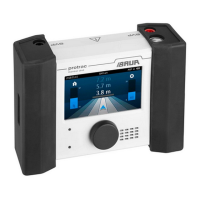20
Tips
Evaluation of the acoustic and electromagnetic signals
For acoustic pin-pointing using protrac®, the propagation times of the acoustic and
electromagnetic signals are compared (coincidence method). This is helpful, for exa-
mple, for cables laid in pipes or under concrete: The acoustic signal is often loudest at
the end of a pipe or concrete slab, which can be misleading. Only by comparison with
the electromagnetic signal can the distance be precisely and reliably determined.
Cable break – connecting the SSG
» Single-phase cable: Short the faulty phase with the screen and with the station
earth at the far end.
» Multi-phase cable: Short all phases with the screen and with the station earth at
the far end.
Changing faults
Faults can disappear temporarily during pin-pointing. This can be due to the fault
changing, moisture or the selected output voltage being too low.
» If permitted, increase the output voltage on the SSG.
» Note, however, that high and long-lasting surge voltages change the fault and can
make fault location more dicult.
Pin-pointing in strong wind
Strong wind can aect the sensitivity of the AGP.
» To improve the sensitivity of the AGP in strong wind (noise level), remove the
handle.
Display of directional arrow
Severe temporary faults can lead to incorrect measurements. Measurements are there-
fore only evaluated if the acoustic and electromagnetic signals lie within a certain time
period. protrac® evaluates the signals received and displays the measurement certain-
ty: The darker the directional arrow, the more reliable is the measurement.
protrac® pin-pointing system 822-186-4
Acoustic pin-pointing – tips, settings

